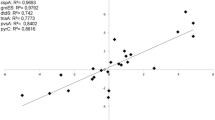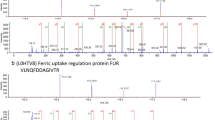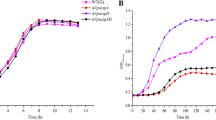Abstract
Vibrio parahaemolyticus is a kind of food-borne pathogenic bacterium, which can seriously infect food, especially seafood causing gastroenteritis and other disease. We studied the global proteome responses of V. parahaemolyticus under cold stress by nano-liquid chromatography-tandem mass spectrometry to improve the present understanding of V. parahaemolyticus proteomics events under cold stress. A total of 1151 proteins were identified and 101 proteins were differentially expressed, of which 69 were significantly up-regulated and 32 were downregulated. Functional categorization of these proteins revealed distinct differences between cold-stressed and control cells. These proteins were grouped into 21 functional categories by the clusters of orthologous groups (COG) analysis. The most of up-regulated proteins were functionally categorized as nucleotide transport and metabolism, transcription, function unknown, and defense mechanisms. These up-regulated proteins play an important role under cold stress.

Similar content being viewed by others
References
Feldhusen F (2000) The role of seafood in bacterial foodborne diseases. Microbes Infect 2:1651–1660
Liston J (1990) Microbial hazards of seafood consumption. Food Technol 44:56–62
Su YC, Liu C (2007) Vibrio parahaemolyticus: a concern of seafood safety. Food Microbiol 24:549–558
Chiang ML, Ho WL, Chou CC (2008) Ethanol shock changes the fatty acid profile and survival behavior of Vibrio parahaemolyticus in various stress conditions. Food Microbiol 25:359–365
Browne N, Dowds BC (2002) Acid stress in the food pathogen Bacillus cereus. J Appl Microbiol 92:404–414
Lou Y, Yousef AE (1997) Adaptation to sublethal environmental stress protects Listeria monocytogenes against lethal preservation factors. Appl Environ Microbiol 63:1252–1255
Gualerzi CO, Pon CL (1990) Initiation of mRNA translation in prokaryotes. Biochemistry 29:5881–5889
Phadtare S (2004) Recent developments in bacterial cold-shock response. Curr Issues Mol Biol 6:125–136
Phadtare S, Alsina J, Inouye M (1999) Cold-shock response and cold-shock proteins. Curr Opin Microbiol 2:175–180
Weber MH, Marahiel MA (2003) Bacterial cold shock responses. Sci Prog 86:9–75
Jia J, Chen Y, Jiang Y, Tang J, Yang L, Liang C, Jia Z, Zhao L (2014) Visualized analysis of cellular fatty acid profiles of Vibrio parahaemolyticus strains under cold stress. FEMS Microbiol Lett 357:92–98
Xuan G, Jia J, Chen Y, Wang J, Tang J, Jiang Y, Xu B, Liang C, Li M (2015) Strain-level visualized analysis of cold-stressed Vibrio parahaemolyticus based on MALDI–TOF mass fingerprinting. Microb Pathog 88:16–21
Lilley KS, Razzaq A, Dupree P (2002) Two-dimensional gel electrophoresis: recent advances in sample preparation, detection and quantitation. Curr Opin Chem Biol 6:46–50
Durack J, Ross T, Bowman JP (2013) Characterisation of the transcriptomes of genetically diverse Listeria monocytogenes exposed to hyperosmotic and low temperature conditions reveal global stress-adaptation mechanisms. PLoS ONE 8:e73603
López-Ferrer D, Martínez-Bartolomé S, Villar M, Campillos M, Martín-Maroto F, Vázquez J (2004) Statistical model for large-scale peptide identification in databases from tandem Mass Spectra using SEQUEST. Anal Chem 76:6853–6860
Zhou L, Zhao SZ, Koh SK, Chen L, Vaz C, Tanavde V, Li XR, Beuerman RW (2012) In-depth analysis of the human tear proteome. J Proteom 75:3877–3885
Griffiths JR, Chicooree N, Connolly Y, Neffling M, Lane CS, Knapman T, Smith DL (2014) Mass spectral enhanced detection of Ubls using SWATH acquisition: MEDUSA—simultaneous quantification of SUMO and ubiquitin-derived isopeptides. J Am Soc Mass Spectrom 25:767–777
Old WM, Meyer-Arendt K, Aveline-Wolf L, Pierce KG, Mendoza A, Sevinsky JR, Resing KA, Ahn NG (2005) Comparison of label-free methods for quantifying human proteins by shotgun proteomics. Mol Cell Proteom 4:1487–1502
Tatusov RL, Galperin MY, Natale DA, Koonin EV (2000) The COG database: a tool for genome-scale analysis of protein functions and evolution. Nucleic Acids Res 28:33–36
Wu S, Zhu Z, Fu L, Niu B, Li W (2011) WebMGA: a customizable web server for fast metagenomic sequence analysis. BMC Genom 12:444
Kurokawa K, Itoh T, Kuwahara T, Oshima K, Toh H, Toyoda A, Takami H, Morita H, Sharma VK, Srivastava TP, Taylor TD, Noguchi H, Mori H, Ogura Y, Ehrlich DS, Itoh K, Takagi T, Sakaki Y, Hayashi T, Hattori M (2007) Comparative metagenomics revealed commonly enriched gene sets in human gut microbiomes. DNA Res 14:169–181
Kim EY, Kim YR, Kim DG, Kong IS (2012) A susceptible protein by proteomic analysis from Vibrio anguillarum under various environmental conditions. Bioprocess Biosyst Eng 35:273–282
Vorob’eva LI (2004) Stressors, stress reactions and survival of bacteria. Prikl Biokhim Mikrobiol 40:261–269
Polissi A, De Laurentis W, Zangrossi S, Briani F, Longhi V, Pesole G, Dehò G (2003) Changes in Escherichia coli transcriptome during acclimatization at low temperature. Res Microbiol 154:573–580
Wouters JA, Jeynov B, Rombouts FM, de Vos WM, Kuipers OP, Abee T (1999) Analysis of the role of 7 kDa cold-shock proteins of Lactococcus lactis MG1363 in cryoprotection. Microbiology 145:3185–3194
Charollais J, Dreyfus M, Iost I (2004) CsdA, a cold-shock RNA helicase from Escherichia coli, is involved in the biogenesis of 50S ribosomal subunit. Nucleic Acids Res 32:2751–2759
Dersch P, Kneip S, Bremer E (1994) The nucleoid-associated DNA-binding protein H-NS is required for the efficient adaptation of Escherichia coli K-12 to a cold environment. Mol Gen Genet 245:255–259
Mihoub F, Mistou MY, Guillot A, Leveau JY, Boubetra A, Billaux F (2003) Cold adaptation of Escherichia coli: microbiological and proteomic approaches. Int J Food Microbiol 89:171–184
Miladi H, Soukri A, Bakhrouf A, Ammar E (2012) Expression of ferritin-like protein in Listeria monocytogenes after cold and freezing stress. Folia Microbiol 57:551–556
Wood RR, Arias CR (2011) Evaluation of global gene expression during cold shock in the human pathogen Vibrio vulnificus. Mar Biotechnol 13:942–954
Jia J, Chen Y, Jiang Y, Li Z, Zhao L, Zhang J, Tang J, Feng L, Liang C, Xu B, Gu P, Ye X (2015) Proteomic analysis of Vibrio metschnikovii under cold stress using a quadrupole Orbitrap mass spectrometer. Res Microbiol 166:618–625
Yang L, Zhou D, Liu X, Han H, Zhan L, Guo Z, Zhang L, Qin C, Wong HC, Yang R (2009) Cold-induced gene expression profiles of Vibrio parahaemolyticus: a time-course analysis. FEMS Microbiol Lett 291:50–58
Jones PG, VanBogelen RA, Neidhardt FC (1987) Induction of proteins in response to low temperature in Escherichia coli. J Bacteriol 169:2092–2095
Jiang W, Hou Y, Inouye M (1997) CspA, the major cold-shock protein of Escherichia coli, is an RNA chaperone. J Biol Chem 272:196–202
Nakashima K, Kanamaru K, Mizuno T, Horikoshi K (1996) A novel member of the cspA family of genes that is induced by cold shock in Escherichia coli. J Bacteriol 178:2994–2997
Wang N, Yamanaka K, Inouye M (1999) CspI, the ninth member of the CspA family of Escherichia coli, is induced upon cold shock. J Bacteriol 181:1603–1609
Walker GC (1984) Mutagenesis and inducible responses to deoxyribonucleic acid damage in Escherichia coli. Microbiol Rev 48:60–93
Sugino A, Peebles CL, Kreuzer KN, Cozzarelli NR (1977) Mechanism of action of nalidixic acid: purification of Escherichia coli nalA gene product and its relationship to DNA gyrase and a novel nicking-closing enzyme. Proc Natl Acad Sci USA 74:4767–4771
Friedman DI, Olson ER, Georgopoulos C, Tilly K, Herskowitz I, Banuett F (1984) Interactions of bacteriophage and host macromolecules in the growth of bacteriophage lambda. Microbiol Rev 48:299–325
Thieringer HA, Jones PG, Inouye M (1998) Cold shock and adaptation. BioEssays 20:49–57
Lelivelt MJ, Kawula TH (1995) Hsc66, an Hsp70 homolog in Escherichia coli, is induced by cold shock but not by heat shock. J Bacteriol 177:4900–4907
Kandror O, DeLeon A, Goldberg AL (2002) Trehalose synthesis is induced upon exposure of Escherichia coli to cold and is essential for viability at low temperatures. Proc Natl Acad Sci USA 99:9727–9732
Kandror O, Goldberg AL (1997) Trigger factor is induced upon cold shock and enhances viability of Escherichia coli at low temperatures. Proc Natl Acad Sci USA 94:4978–4981
Toone WM, Rudd KE, Friesen JD (1991) deaD, a new Escherichia coli gene encoding a presumed ATP-dependent RNA helicase can suppress a mutation in rpsB, the gene encoding ribosomal protein S2. J Bacteriol 173:3291–3302
Dammel CS, Noller HF (1995) Suppression of a cold-sensitive mutation in 16S rRNA by overexpression of a novel ribosome-binding factor, RbfA. Genes Dev 9:626–637
Chen C, Deutscher MP (2005) Elevation of RNase R in response to multiple stress conditions. J Biol Chem 280:34393–34396
Qin T, Hu X, Hu J, Wang X (2015) Metabolic engineering of Corynebacterium glutamicum strain ATCC13032 to produce l-methionine. Biotechnol Appl Biochem 62:563–573
Raïs B, Mazat JP (1995) Control of the metabolic pathway of threonine in E coli. Application of biotechnology. Acta Biotheor 43:143–153
Tang H, Wang E, Sui X, Man C, Jia R, Lin D, Qu Z, Chen W (2007) The novel alkali tolerance function of tfxG in Sinorhizobium meliloti. Res Microbiol 158:501–505
Sleator RD, Gahan CG, Hill C (2001) Identification and disruption of the proBA Locus in Listeria monocytogenes: role of proline biosynthesis in salt tolerance and murine infection. Appl Environ Microbiol 67:2571–2577
Bode M, Longen S, Morgan B, Peleh V, Dick TP, Bihlmaier K, Herrmann JM (2013) Inaccurately assembled cytochrome c oxidase can lead to oxidative stress-induced growth arrest. Antioxid Redox Signal 18:1597–1612
Usuda Y, Nishio Y, Iwatani S, Van Dien SJ, Imaizumi A, Shimbo K, Kageyama N, Iwahata D, Miyano H, Matsui K (2010) Dynamic modeling of Escherichia coli metabolic and regulatory systems for amino-acid production. J Biotechnol 147:17–30
Li H, Park JT (1999) The periplasmic murein peptide-binding protein MppA is a negative regulator of multiple antibiotic resistance in Escherichia coli. J Bacteriol 181:4842–4847
Parada C, Orruño M, Kaberdin V, Bravo Z, Barcina I, Arana I (2016) Changes in the Vibrio harveyi cell envelope subproteome during permanence in cold seawater. Microb Ecol 72:549–558
Jia J, Li Z, Cao J, Jiang Y, Liang C, Liu M (2013) Proteomic analysis of protein expression in the induction of the viable but nonculturable state of Vibrio harveyi SF1. Curr Microbiol 67:442–447
Chiancone E, Ceci P (2010) The multifaceted capacity of Dps proteins to combat bacterial stress conditions: detoxification of iron and hydrogen peroxide and DNA binding. Biochim Biophys Acta 1800:798–805
Yu F, Inouye S, Inouye M (1986) Lipoprotein-28, a cytoplasmic membrane lipoprotein from Escherichia coli. Cloning, DNA sequence, and expression of its gene. J Biol Chem 261:2284–2288
Urmersbach S, Aho T, Alter T, Hassan SS, Autio R, Huehn S (2015) Changes in global gene expression of Vibrio parahaemolyticus induced by cold- and heat-stress. BMC Microbiol 15:229
Rogers S, Girolami M, Kolch W, Waters KM, Liu T, Thrall B, Wiley HS (2008) Investigating the correspondence between transcriptomic and proteomic expression profiles using coupled cluster models. Bioinformatics 24:2894–2900
Acknowledgements
We thank Dr. Mingwei Liu (Beijing Proteome Research Center) for sample preparation and Mass Spectrometry analysis. This work was supported by the Chinese State High-Tech Development Plan (2012AA101605), the Science Foundation of General Administration of Quality Supervision, Inspection, and Quarantine of the People’s Republic of China (2012IK305, 2013IK175, and 2016IK198).
Author information
Authors and Affiliations
Corresponding author
Electronic supplementary material
Below is the link to the electronic supplementary material.
Rights and permissions
About this article
Cite this article
Tang, J., Jia, J., Chen, Y. et al. Proteomic Analysis of Vibrio parahaemolyticus Under Cold Stress. Curr Microbiol 75, 20–26 (2018). https://doi.org/10.1007/s00284-017-1345-4
Received:
Accepted:
Published:
Issue Date:
DOI: https://doi.org/10.1007/s00284-017-1345-4




